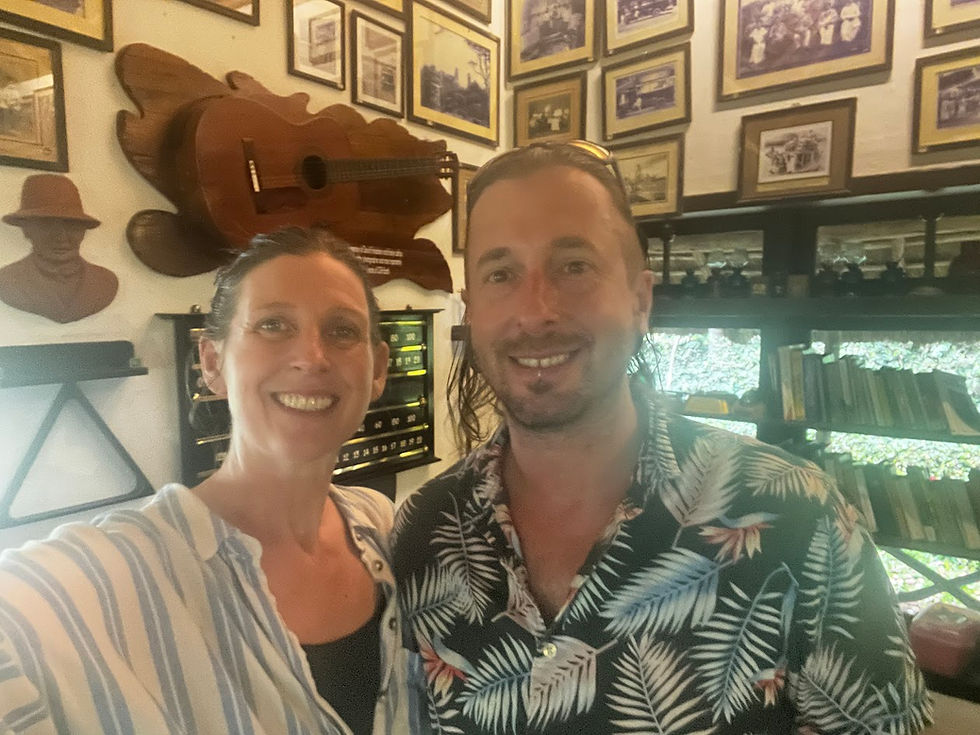From Tea Plantations to Backwaters: Our journey through Kerala
- Helen Bateman

- Aug 17
- 8 min read
Updated: Aug 28
The small state of Kerala stretches along the south west of India. A lush and tropical region, famed for its coconutty cuisine and lazy backwaters. Nick & I have both visited Kerala in the past, whilst working at Dragoman, but this trip was planned to be a relaxing holiday, dotted with little luxuries, eco resorts, our own driver & private guided tours and activities. I am very excited about lazing around the palm-fringed swimming pools with a mango lassi and Kerala's fantastic vegetarian food.

Kerala packs a lot into relatively short distances. From misty mountain tea plantations to tranquil backwaters, wildlife filled national parks and characterful cities, each destination offered something completely different - and utterly captivating.

Kochi: Gateway to Kerala's rich heritage
Our Kerala adventure began in Kochi, where centuries of maritime trade have created a fascinating cultural melting pot. The city's famous Chinese fishing nets frame stunning sunsets, whilst dolphins play just beyond the harbour (locally known as sea-pigs, I couldn’t find out why) Walking the promenades under giant trees provides welcome shade, and the blend of Portuguese, Dutch, and British colonial architecture tells stories of Kerala's past. We watched as a Bollywood movie was being filmed on a busy side street and went explored the craft shops of Jew town.
Kerala celebrates both vegetarian cuisine and exceptional seafood. The coconut milk and spices create rich, creamy flavours that are distinctly South Indian. We stayed at the Eighth Bastion, a lovely hotel in Fort Kochi. Big rooms overlooking the pool garden and quiet nooks for reading. The menu full to the brim of regional and national options, was clearly labelled for all sorts of food requirements and allergies. I loved the paneer and veggie kebabs. The atmosphere at the hotel was calm and welcoming.

It was great to take a guided tour of Kochi, as there’s so much history and points of interest to take in. Of particular note is the shiniest Dutch Palace, full of frescos, paintings and old furniture. We learned about fighters with flexible swords worn around the waist - I was intrigued so our guide suggested to our driver that we add a visit to a performance later in the trip. We also learned about the Jewish community and visited the synagogue of Kochi, the area is lovely and certainly worth a visit for a wander around the craft shops.
Munnar: cool respite in the tea mountains
The journey from Kochi to Munnar is a lovely. As you climb into the Western Ghats, the steamy coastal heat gives way to pleasantly cool mountain air. Munnar sits at 1,600 metres above sea level, where mist clings to hillsides carpeted in emerald tea plants. The landscape is stunning.
We visited the Kanan Devan Hills museum which dates back to the Duke of Wellington in 1790, and the Lockhart Tea Factory, a cooperative which allows visitors to explore and learn about life in the area. Apparently tea pickers have a daily target of 27kg of tea leaves collected over eight hours, the factory provides healthcare and education for workers and their families and have workers involved in the management of the factory. It was an example of how responsible tourism can support local communities. Knowing how much effort goes into the tea process, I'll appreciate my next cup of tea more.

The cool climate here (around 25°C compared to 32°C on the coast) makes Munnar perfect for gentle hiking and exploring. It did rain a bit during our trip, though we expected this as we visited in May. I think the misty mornings and rain showers add to the atmospheric charm of this mountain retreat. We spent three nights at the Windsor Estate, with giant squirrels & exotic birds right outside our veranda, this is the perfect place for a quiet few days of R&R. The estate is has a great viewing area on the top of a big boulder, a dining room with a library and games room upstairs, a lovely pool and accommodation spread across the grounds. A highlight is a afternoon tea & snacks served in the gazebo.


The estate has a naturalist guide on site who guided us on morning and evening nature walks. She was extremely knowledgeable and it was fun to learn more about the birds and minibeasts of the area.
I was treated to a gorgeous home made birthday cake, such a lovely gesture from the hotel - we just wished they’d told us about it before serving up apple pie for desert. Too polite, we powered through our cake and had to roll out of the dining room.
Thekkady: Where spice gardens meet wild encounters
Just a few hours drive from Munnar to Thekkady shows off Kerala's dramatic geography. You'll descend from misty hills through granite boulder landscapes and forest-clad slopes into the valley below. It's an incredibly scenic journey that demonstrates how quickly India's landscapes can transform.


Thekkady borders Periyar National Park, and staying at the CGH Earth Spice Village sets you amongst native trees, in thatched cottages just on edge of the village. The organic kitchen gardens, composting systems, and commitment to sustainability show how luxury and environmental responsibility can work hand in hand. There are daily cooking demos and classes you can join and I spent a lovely morning practicing yoga (there are classes led daily at each of the properties we stayed in).
Don't miss the traditional martial arts performance, watching Kerala's ancient fighting techniques with flexible swords and spears provides an insight into local culture.
As I was celebrating my birthday here, Nick treated me to an Ayurvedic treatment, which was wonderfully relaxing and restorative.

The big attraction in Thekkady is the Periyar National Park, India’s first tiger reserve. The park is carefully managed, and visitors must have a guide from the local community. Access is by bus, then visitors separate to take a boat trip on the lake or like us go for a trek through the forest. This was cool, but I had my first experience of wearing leech socks, which fit inside your shoes and are tied above the knee. We certainly needed them, the leeches were crazy active and fast moving - eek!

I loved the old hunting lodge, now a bar at the Spice village. It's filled with old letters and photographs and games tables to keep you entertained. The staff team are lovely and we relaxed with cocktails as we waited for dinner and another delicious birthday cake.
Kumarakom: Tranquil backwaters and wildlife

The backwaters of Kerala are really special. What were once working waterways for transporting goods have become one of India's most peaceful destinations. I'd highly recommend the Coconut Lagoon, where reclaimed heritage buildings sit amongst canals and rice paddies. We arrived by boat, to be welcomed with a coconut water in the lovely open reception area. Within an hour we'd spotted an otter (well Nick did), a monitor lizard, and birds of prey. It was bliss.

Lake Vembanad - India's longest lake - stretches to the horizon, whilst quiet canals wind through the landscape. Taking early morning boat trip revealed a thriving ecosystem: kingfishers, herons, storks, and more otters going about their daily business in these tranquil waters. We also took an evening sunset cruise on the lake which was beautiful.
The swimming pool at Coconut Lagoon is stunning and as cooled off in the pool, Nick went off for a run to explore the area (by this time he was famous with other guests for running around in the heat).
For most, the pace is deliberately slow. Whether exploring by bicycle along quiet lanes or taking sunset cruises, Kumarakom encourages you to unwind completely. This is Kerala at its most serene. Though we did enjoy whizzing around on our electric bikes.

This was a favourite stop on the route for me, so I’d suggest an extra night here if you have time. At each of the CGH Earth properties, you’re treated to afternoon tea and at the Coconut lagoon a lady arrives by boat with chai & snacks each day - what a treat!
Mararikulam: Golden Beaches and Village Life

Our final stop was Mararikulam, a sleepy fishing village two hours south of Kochi. The golden sand beach stretches endlessly, dotted with colourful fishing boats and shaded by palm trees. It's the perfect place to end a Kerala journey and only a couple of hours from the airport in Kochi, as we'd travelled in a loop.
We stayed at Marari Beach Resort, which was both beautiful and demonstrated excellent community tourism - creating employment whilst preserving local customs. Watching craftsmen replace palm thatch roofs using traditional techniques and local materials shows how tourism can celebrate rather than diminish cultural heritage.

The accommodation is spread across individual thatched bungalows, we had an outdoor rainfall shower and the customary selection of teas and coffees in our room. The pool is surrounded by leafy palms swaying in the breeze and when you're ready for a wander, there's a thriving butterfy garden to explore, a kitchen garden and plenty of hammocks to relax with a book.
Exploring by bike shows authentic village life: hardware shops, telephone poles being installed by hand, and the gentle rhythm of local daily life. This isn’t a place set up for tourism beyond the resort, so come prepared to relax beneath the palms, read a book or float about in the pool. As with the other properties we stayed in, there is a daily yoga, meditation and nature walks to join.
The Magic of Kerala
Kerala offers such great variety within a compact area. In just a few hours' drive, you'll experience dramatic climate changes, from steamy coast to cool mountains. You'll encounter dense jungle, spice plantations, maze-like canals, and quiet beaches with warm waters.

For vegetarians, Kerala is paradise. The abundance of plant-based options means you'll never run short of delicious choices and seafood lovers will discover some of India's finest coastal cuisine. If you have any food allergies, all the hotels we visited had clear and extensive food labelling.
Kerala certainly packs it all in. Twelve days gave us a wonderful insight, but you could easily spend double the time here. For travellers seeking diversity, culture, and natural beauty - all with excellent infrastructure and accommodation - Kerala delivers an experience that's both authentically Indian, comfortably accessible and full of little luxuries teamed with responsible tourism initiatives.
Everyone we met at the hotels recommended the time to visit Kerala is October to March, when temperatures are more comfortable and rainfall minimal. This timing allows you to fully enjoy everything from mountain treks to beach relaxation. We went in May and whilst it was quite hot and humid we still had an amazing time.
I'd like to say a huge thank you to our team at TBi who put the programme together for us and looked after us so well during the holiday.
If you'd like to enjoy this trip for yourself, head over to Highlights of Kerala for an in depth itinerary, inclusions and accommodation suggestions. This tour is fully customisable and you may wish to add nights in some of the destinations.
By Helen Bateman
01728850024

















































Comments